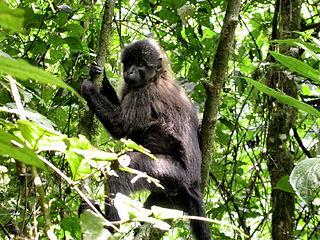
The crested mangabeys are West African Old World monkeys belonging to the genus Lophocebus. They tend to have dark skin, eyelids that match their facial skin, and crests of hair on their heads. Another genus of mangabeys, Cercocebus, was once thought to be very closely related, so much so that all the species were placed in one genus. However, Lophocebus species are now understood to be more closely related to the baboons in genus Papio, while the Cercocebus species are more closely related to the mandrill. In 2006, the highland mangabey was moved from Lophocebus to a new genus, Rungwecebus.

Thysanichthys is a genus of marine ray-finned fishes belonging to the family Scorpaenidae, it is a monotypic genus with its only species being Thysanichthys crossotus. This species is found in the northwestern Pacific Ocean.

The Uganda mangabey is a species of Old World monkey found only in Uganda and in the Minziro Forest Reserve, just over the border in Tanzania. This crested mangabey was previously thought to just be a population of the grey-cheeked mangabey. Colin Groves upgraded the Ugandan population to the new species L. ugandae on 16 February 2007. This species is significantly smaller than the grey-cheeked mangabey, with a shorter skull and smaller face. 2008 was the most recent year in which the International Union for Conservation of Nature assessed the conservation status of L. albigena, describing it as being of least concern, and the status of L. ugandae has not been assessed separately.
Melbournopterus is a genus of prehistoric chelicerate or brachiopod, known from the Upper Silurian of Australia. It is of uncertain taxonomic placement within the subphylum Chelicerata. Lamsdell, Percival and Poschmann (2013) argued that Melbournopterus crossotus is not a chelicerate at all, and interpreted its type specimen as the dorsal valve of a craniate brachiopod.
Johnston's mangabey is a species of crested mangabey in the family Cercopithecidae. It had been considered a subspecies of the gray-cheeked mangabey, but was elevated to species Level in 2007, alongside Osman Hill's mangabey and the Uganda mangabey.

Dactyloscopus crossotus, the bigeye stargazer, is a species of sand stargazer native to the coastal Atlantic waters of Florida, United States and from the Bahamas to Brazil where it prefers sandy beaches at depths of from 0 to 3 metres, occasionally down to 8 metres (26 ft). It buries itself in the sand to ambush prey, leaving only its eyes, mouth and nose exposed. It can reach a maximum length of 7.5 centimetres (3.0 in) TL.
Hewitsonia ugandae is a butterfly in the family Lycaenidae. It is found in Cameroon, Gabon, the Democratic Republic of the Congo and western Uganda.
Ornipholidotos ugandae is a butterfly in the family Lycaenidae. It is found in Cameroon, Equatorial Guinea, the Republic of the Congo, Gabon, Angola, the Central African Republic, the Democratic Republic of the Congo, Uganda and Tanzania. The habitat consists of forests.
Micropentila ugandae is a butterfly in the family Lycaenidae. It is found in Cameroon, Gabon, the Republic of the Congo, the Democratic Republic of the Congo, Uganda and north-western Tanzania. The habitat consists of primary forests.

Crossotus is a genus of longhorn beetles of the subfamily Lamiinae.
Crossotus albicollis is a species of beetle in the family Cerambycidae. It was described by Félix Édouard Guérin-Méneville in 1844. It is known from Ethiopia, Burkina Faso, Chad, the Central African Republic, Ghana, Ivory Coast, Cameroon, Senegal, Mali, Morocco, Niger, Nigeria, Kenya, Mauritania, and Western Sahara.
Crossotus arabicus is a species of beetle in the family Cerambycidae. It was described by Gahan in 1896.
Crossotus brunneopictus is a species of beetle in the family Cerambycidae. It was described by Fairmaire in 1891.
Crossotus erlangeri is a species of beetle in the family Cerambycidae. It was described by Hintz in 1912.
Crossotus klugi is a species of beetle in the family Cerambycidae. It was described by William Lucas Distant in 1892. It is known from Botswana, South Africa, Namibia, Mozambique, and Zimbabwe.

Crossotus plumicornis is a species of beetle in the family Cerambycidae. It was described by Audinet-Serville in 1835. It is known from Botswana, Chad, Ethiopia, Guinea, Mauritania, Burkina Faso, Ivory Coast, Malawi, Mali, Mozambique, South Africa, Kenya, Namibia, Eritrea, Senegal, Somalia, Tanzania, Sudan, Zambia, Uganda, and Zimbabwe.

Crossotus stypticus is a species of beetle in the family Cerambycidae. It was described by Pascoe in 1869. It is known from Mozambique, Botswana, South Africa, Namibia, and Tanzania.
Crossotus sublineatus is a species of beetle in the family Cerambycidae. It was described by Gestro in 1892. It is known from Chad, Algeria, Mauritania, Djibouti, Ethiopia, Somalia, Mali, Morocco, Kenya, Niger, Senegal, and Sudan.

Crossotus vagepictus is a species of beetle in the family Cerambycidae. It was described by Fairmaire in 1886. It contains the varietas Crossotus vagepictus var. niveicollis.
Pterolophia ugandae is a species of beetle in the family Cerambycidae. It was described by Stephan von Breuning in 1938. It is known from Uganda and Angola. It contains the subspecies Pterolophia ugandae ugandae.





